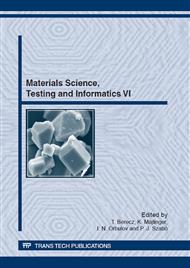p.379
p.385
p.391
p.397
p.403
p.409
p.415
p.419
p.424
Effect of Organic Additives on Friction Properties of Clay Based Compounds
Abstract:
In the traditional heavy-clay industry, compounds are usually prepared by the addition of organic waste material. These additives originate mainly from the wood, food or paper industries. The purpose of this study is to present the results of the examination of friction contact between the wall of the forming die and the clay compounds containing organic additives. Saw dust and ground sunflower seed shell were mixed to clay in 0 wt%, 3 wt% and 5 wt%. The water content of compounds was also varied. The clay and the additives were described by morphology, XRD, bulk density and equivalent diameter. Friction tests were carried out on a special tribometer up to plastic deformation of the sample. The coefficient of friction decreased when normal stress was increased for all the ten compounds. Average results showed that the tendency of change in the value of the coefficient of friction could be divided into three sections: a decreasing, a quasi constant and a shearing section. It follows from this that the coefficient of friction can be characterized with a number only inside the quasi constant section, i.e. between two definable normal stress values. Averaged coefficient of friction was between 0.17 and 0.21 for saw dust and between 0.19 and 0.21 for the compounds with ground sunflower seed shell.
Info:
Periodical:
Pages:
403-408
Citation:
Online since:
November 2012
Keywords:
Price:
Сopyright:
© 2013 Trans Tech Publications Ltd. All Rights Reserved
Share:
Citation:


